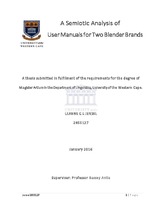| dc.description.abstract | Technical documentation comes in a variety of forms such as installation or operation manuals, quick reference guides, maintenance manuals, user manuals, policy and procedure manuals or marketing brochures and flyers (Walsh, 2012). What all these sub-genres have in common is that the texts that correspond to them seek to inform and give instruction about procedures, behaviour and actions related to products (Schäffner & Wiesemann, 2001: 49). Manuals have been
described as “the complete reference source for a product’s operation, maintenance and safety” (Cowley & Wogalter, 2011: 1773). For the purpose of this study, we will focus on one form of technical documentation, namely user manuals. The terms “documentation” and “manuals” will be used interchangeably. Although there are probably as many manuals as there are products in our homes, these user manuals have not frequently been the subject of academic study in the South African context. The relative lack of research into user manuals is especially regrettable at a time when new product liability legislation and trade regulations (e.g. the Consumer Protect Act of South Africa, 2008) have enhanced the profile of product manuals in public and regulatory discourse. As a result of this relative neglect, it is not known how understandable, relevant and therefore empowering users of products find these manuals. There is also not much knowledge concerning
the level of compliance in manuals to the provisions of product liability legislation. This study therefore proposes to investigate the comprehensibility and usability of user manuals associated with two products (blenders) marketed in South Africa. It will draw on theories and methods of analysis associated with technical writing, analysis of terminological consistency, genre and multimodality, to evaluate the selected manuals from the standpoint of a subset of the criteria listed in Section 22(2) of the Consumer Protection Act of South Africa, No. 68 of 2008, which was later amended in 2011. The methodology for the proposed study will combine text
analysis (by the researcher) with comprehension and usability tasks performed by selected participants. Data from these sources will be collated and analysed to determine the conformity of the manuals to criteria in the Consumer Protection Act of South Africa, and the effect the manuals have on product users. Areas for optimising (improving) the manuals will also be identified. | en_US |

